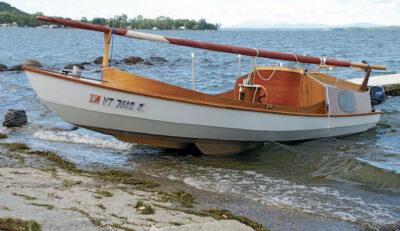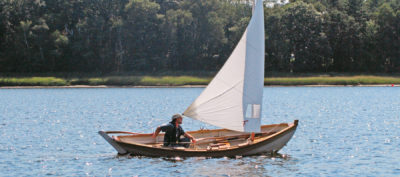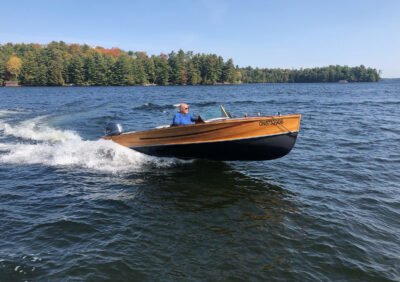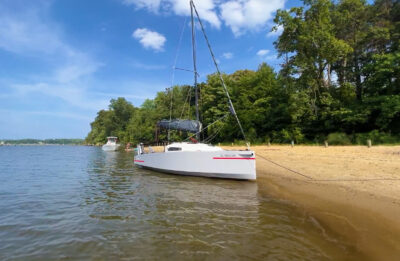While she was originally intended for the pursuit of striped bass and bluefish in the choppy waters of Block Island Sound and the Gulf of Mexico, Ninigret is well suited to a wide range of uses including family outings and picnics, weekend cruising, or any other activity that benefits from quiet, economical operation, lots of room, and a smooth ride.
 Roeboats
RoeboatsWhile John Atkin designed Ninigret for fishing the choppy waters of Block Island Sound, the boat also makes a superb camp-cruiser. Irish boatbuilder Tiernan Roe built the fine example in the photograph above.
An easily driven hull allows Ninigret to use a relatively small outboard of around 25 hp, though she can handle as much as 60 hp. With a 30-hp four-stroke Honda outboard she has been shown to burn less than a gallon of fuel per hour at 15–20 knots depending on how she is loaded. Thus the initial expense of the motor is about as little as it could be for a boat this size, and her operating costs are likewise near the minimum. It stands to reason that a boat that is cheap to run will be run more often.
Unlike the short, heavy, high-powered boats that have been so popular in recent years, Ninigret planes easily at moderate speeds without much change in trim and without making big waves at any point in her speed range. In really rough water she can be slowed down, and she will still handle well and be safe and comfortable. This easy feel in a wide range of conditions is part of her agreeable personality.
“Designer John Atkin had a particular talent for creating “timeless” designs, and Ninigret is a prime example.”
Designer John Atkin had a particular talent for creating “timeless” designs, and Ninigret is a prime example. Introduced in 1963, she still has a fresh and contemporary look today, and we expect that decades hence, people will have the same reaction. At the same time, all who love the emotion in well-drawn traditional lines will find her easy on the eyes. Ninigret became one of John’s most popular designs, with more being built every year almost a half-century after she was drawn.
 Roeboats
RoeboatsThe motor on Tiernan Roe’s Ninigret is concealed by a hatch.
One of the weak points of many outboard-powered boats is a vulnerability to seas approaching the boat from behind, when the boat is stopped. Normally the transom of an outboard boat is plumb or nearly so, and the weight of the motor is all at the extreme aft end of the boat.
When a large sea comes from that direction, the stern of the boat has little tendency to lift to it, and commonly water pours around the motor and over the top of the transom, leaving the boat dependent on whatever defenses are inboard of the motor, if any. When outboard boats lose power they typically turn away from the wind, and many otherwise good boats are lost each year because they could not cope with seas impacting the boat from behind. In Ninigret, the motorwell arrangement allows a flaring transom, plus freeboard and buoyancy aft that are more typical of an inboard-powered boat—a major improvement in safety.
 Timm Schleiff
Timm SchleiffTimm Schleiff’s motor sits handsomely in an exposed well.
While today’s outboards are not very susceptible to stalling as a result of wave impacts, there is obviously still a limit to how deeply they can be immersed in a wave without trouble. Ninigret’s outboard is almost completely protected from waves and also from collision. While we hate to think it is a problem one has to consider, we should note that its location in the well makes the motor much less likely to be stolen.
The outboard’s location also makes possible effective soundproofing of the motor. Few things improve a day on the water as much as simple peace and quiet, and a four-stroke outboard with good sound insulation is the about the quietest option available today, short of an electric motor.
 Timm Schleiff
Timm SchleiffBoatbuilder Timm Schleiff (see WoodenBoat No. 215) built this glued-lapstrake plywood Ninigret in his West Virginia shop.
Compared to an inboard engine, the outboard saves considerably on installation costs, and when it is time to replace the engine, this, too, can happen quickly and at minimal cost, even if the motor is a different make. The aft engine location eliminates the usual ’midships engine box or elevated cockpit sole, leaving Ninigret’s cockpit sole low, level, and unobstructed.
Ninigret’s cockpit is large enough for many activities, and because it is well centered in the boat fore-and-aft, she is able to carry considerable weight without being thrown too far out of trim. Numerous arrangements are possible due to the lack of obstructions or level changes.
 Roeboats
RoeboatsJohn Atkin recommended a 30–45-hp outboard for Ninigret; the corresponding top speed with this power reportedly ranges from 18 to 25 knots. Tiernan Roe’s Ninigret is powered by a 30-hp Honda.
The other very notable feature of this design is her small, canvas-roofed cabin forward. In most motor-boats, a small cabin like this is a seldom-used after- thought, but in Ninigret it is a real plus, adding much to a wide range of uses. For one thing it is an excellent storage area for anything you need to keep dry. Everyone enjoys a day boat more if there is a private place to use the head. Beyond this, it is plenty big enough to sleep in, and one can sit upright on the berths and see out the large windows, which make the cabin cheery and open feeling. Thus Ninigret is a perfectly feasible little cruising boat, and numerous options for cockpit tents or awnings could add much to that potential.
The cabin features a removable canvas roof. The roof will keep the rain out just fine, but when it is removed the entire cabin area becomes a comfortable place for open-air seating and lounging, considerably protected from spray and wind by the cabin sides and windows. As such it is a great place to grab a nap away from the activities in the cockpit, or to ride in comfort with good forward visibility, and it would be a particularly good spot for small children to be safe while they can still see what is going on.
If one wanted, one could make a screen that covered the entire roof area, at which point the cabin would be about the perfect place to sleep on a hot summer night, under the stars. Despite its many contributions, the cabin trunk is relatively low, and taken as a whole the boat has minimal windage that is reasonably well distributed fore and aft. She will not become unmanageable in a strong crosswind, as a result.
 Roeboats
RoeboatsRoe’s boat includes seating for six and accommo-dations that include berths for two and a head.
Ninigret’s hull lines show a boat that is long, lean, and light—everything that an efficient powerboat should be. There will be no big “hump” to climb over to get onto a plane, and indeed the hull will essentially be planing at all speeds because the underwater lines are so shallow and straight. The efficiency of the hull is partly proven by the very small size of the waves it will generate, in motion. The hull is what is called a “warped V” shape, flat under the transom for easy planing and good stability, moderately V’d amidships for minimal pounding, and with a sharp V shape forward, for a soft ride.
Flaring topsides all around make for a dry boat, with lots of reserve buoyancy and stability. The design is well known for a smooth ride at speed, and makes relatively flat, comfortable turns. While she has ample stability, she has a bit slower motion in a beam sea than most boats, which will be much appreciated especially when she is stopped.
Building Atkin’s Ninigret

Ninigret’s sharp forefoot transitions to flat after sections, amounting to quick planing and a dry ride.
Plywood construction is ideal for this type of boat, combining light weight, rigidity, and somewhat reduced maintenance. It will go well with epoxy glue and light fiberglass-and-epoxy sheathing, which will form a good foundation for long-lived two-part paint, if desired. If the amount of varnish is held down to a minimum and two-part paints are used where they are practical, maintenance requirements will be close to the minimum possible.
Builders should not think they are doing the boat any favor by increasing any of the scantlings— relatively light weight is one of the reasons Ninigret is so good at what she does, and the Atkins had vast experience in the priorities of construction. The hull is 3⁄8″ plywood over 5⁄8″ × 2 1⁄2″ white-oak frames. Some examples have been finished plainly while others have been done up yacht fashion. The boat will look great with an all-paint finish or with lots of varnish. Modify this boat with great caution. Seemingly minor changes could throw the whole look and function off, and we highly recommend trusting the famously competent and artistically gifted designer to have gotten it right the first time.
Atkin & Company designed over 800 boats, many of them motorboats, and many design themes similar to Ninigret were returned to and refined again and again over the course of many years. Perhaps there can be no greater recommendation for this design than to point out that she is the boat John Atkin chose for his own use in his retirement. He and his wife, Pat, enjoyed countless picnics and cruises in Ninigret, in Long Island Sound.
Numerous examples of Ninigret have been built in recent years, partly due to increasing interest in fuel economy and in wooden boats in general, but also from a simple desire for great-looking boats that do their jobs really well.
Order Ninigret’s plans from the Mystic Seaport Museum Email: [email protected] Phone Number: 1 (860) 572 5360
More John Atkin Designs
Interested to read more about boat designs by John Atkin and his father, William? Here are a couple you might like.
XLNC Utility Skiff — A motorboat with a simple, efficient hull.
Valgerda — An 18′7″ Hardangersjekte design.














Join The Conversation
We welcome your comments about this article. If you’d like to include a photo or a video with your comment, please email the file or link.